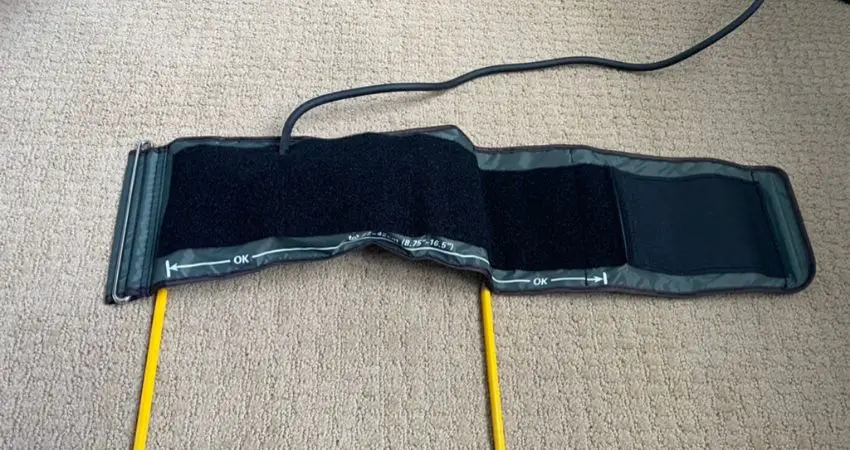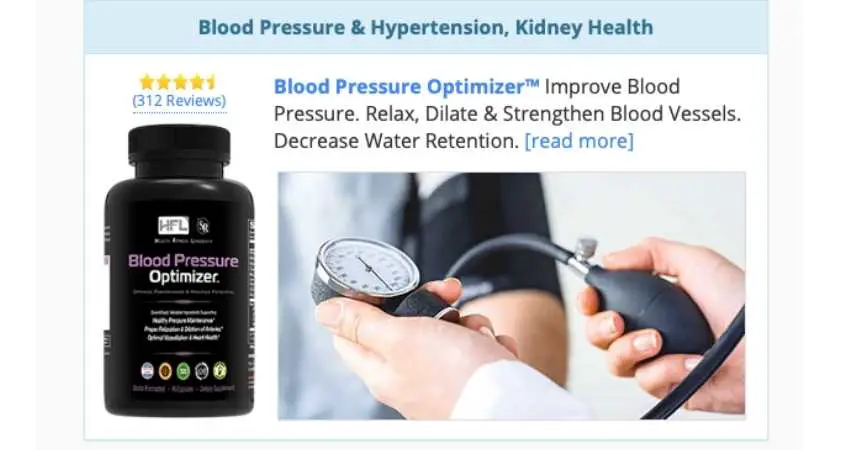The size of your blood pressure cuff is crucial in obtaining an accurate blood pressure measurement. Many monitors come with a standard size cuff and most people assume it’s correct for them. If your cuff is the incorrect size, you may be wondering, what happens to the reading with a blood pressure cuff too large?
A blood pressure cuff too large results in a lower blood pressure measurement than your actual pressure. The larger air bladder will cut off the blood flow in the vessel faster which causes the lower measurement. The American Heart Association recommends a BP cuff bladder length of 75%-100% and width of 37%-50% of the patient’s arm circumference.
In this blog post, I’ll inform you exactly why a cuff too large results in a lower measurement. More importantly, I’ll let you know how you can avoid this costly mistake when measuring your blood pressure at home. Armed with this knowledge, you may even prevent your nurse from making the same mistake at the doctor’s office!
Blood Pressure Tip: Always check the arm circumference range of the cuff included with the home monitor prior to purchasing. The monitor I recommend allows the cuff to be changed if it’s an incorrect size or if you outgrow the original cuff. If you’re looking for a new monitor check Amazon for the current price of the home monitor I highly recommend and use myself. Click here, Welch Allyn 1700 Series.
Disclaimer: Some of links in this article are affiliate links which means I may earn a small commission at no extra cost to you. As an Amazon associate I earn from qualifying purchases.
( Lower Your BP Naturally, In Only 30 Days Or Pay Nothing…Visit Website Here )
Why A BP Cuff Too Large Measures Blood Pressure Lower
Cuff/Bladder Design
Let me explain a little about the design of a BP cuff. Located inside the cuff is an air bladder that fills up with air when you turn your monitor on. It’s not the cuff material you see on the outside that fills with air, the bladder does.
The flexible tubing that connects to your monitor, or to a hand pump used by a nurse, supplies the bladder with air.
Correct Cuff Sizes
The air bladder comes in different sizes. The bigger the cuff size, the bigger the bladder. Also, the smaller the cuff size, the smaller the bladder. The bladder is measured in 2 ways, length and width. The correct size bladder length measurement should be between 75%-100% of the circumference of your upper arm1.
If your upper arm circumference measures 15″, the bladder length should be between 11.25″ and 15″.
The correct size width of the bladder should be between 37%-50% of your arm circumference. A 15″ diameter arm should use a bladder width between 5.55″-7.50″. Typically a blood pressure cuff will state an arm circumference range.
It’s crucial you purchase a monitor with an arm circumference range that fits your arm. The monitor I use comes with a standard size cuff range between 8.75″-16.5″. If your arm measures 15″, typically this size cuff and inside bladder would be appropriate for measuring your blood pressure.
BP cuff too large is one of 14 sections in my article about blood pressure cuffs. Learn more about BP cuffs, including how to apply them, errors made and sizes, here in the article, Blood Pressure Cuffs.

Cuff/Bladder Too Large
If the inside bladder is too large for your arm, when it’s inflating it will squeeze your arm faster than the correct size bladder would. This will cut off the blood supply in your artery faster which results in a lower blood pressure reading.
This is why it’s important to have the correct size cuff. If your blood pressure is high and you’re using a cuff too large, you may be unaware of your correct high blood pressure. This is because you’ll get lower measurements.
The opposite is true if your cuff is too small. I also wrote a blog post on that which you can read by clicking here, Blood Pressure Cuff Too Small.
The following are studies which prove how a larger cuff affects blood pressure. I’ve read reports of an adjustable cuff which would be applicable to all different size arms. One report was 19 years old, so I’m assuming it wasn’t effective. If they can design such a cuff, it solves many problems with undercuffing (too small) or using one too large2.
Studies and Reports
In this report the American Journal of Hypertension states, the use of a cuff too large results in false low blood pressure measurements. They stressed the importance of doctor offices having a variety of correct cuff sizes available3.
Another study measured blood pressure on 137 patients using different cuff sizes. When they used a blood pressure cuff too large, systolic pressure measured 5 mmHg less. The patient’s diastolic pressure didn’t show a significant difference worth mentioning4.
A study used three different cuff sizes to measure blood pressure on 181 adults. One cuff was determined to be the correct size, another one size larger and the last one size smaller. The one size larger cuff decreased blood pressure 3-5 mmHg in men and 1-3 mmHg in women5.
How to Avoid Using a BP Cuff Too Large
Before you purchase a new BP monitor take the following steps to avoid buying one with the wrong size cuff. In addition, you can perform these steps to check your current cuff to make sure it’s the correct size!
Measure the circumference of your upper arm: Keep your arm straight or relaxed and not do not flex. Using a cloth measuring tape, wrap it around the middle of your upper arm. Make sure it’s snug and not too loose or tight.
In addition, make sure it’s wrapped evenly around. Note the number of inches and write it down somewhere along with your blood pressure records.
Check the size range of the blood pressure cuff: All cuffs have a size range printed on the cuff. Make sure the monitor you buy comes with a cuff range that fits your size arm. Some monitors only come with a standard size cuff.
If your arm doesn’t fall into the range, it doesn’t mean you can’t purchase it. As long as the monitor has a cuff that can be changed, you can purchase the monitor and the correct size cuff separately.
Don’t let the cuff size included with the monitor force you to choose another monitor of lesser quality. My Welch Allyn 1700 comes with the standard size cuff which was perfect for my size arm. If it wasn’t, I would still order it and would change the cuff.
The quality an accuracy of the monitor cannot be underestimated!
By the way, changing the cuff to a different size doesn’t require any additional work or expertise. When I store my monitor, I disconnect the cuff everytime. If you found out you need a different size cuff, check on Amazon where they sell many cuffs for different monitors, BP cuffs.
Read Next
Can A Blood Pressure Cuff be Too Tight?
Blood Pressure Cuff Bladder Width
Blood Pressure Cuff Bladder Length
- Hypertension: Measurement of Blood Pressure in Humans: A Scientific Statement From the American Heart Association [↩]
- National Center for Biotechnology Information: Blood pressure measurement [↩]
- Oxford Academic: P-175: Accurate cuff size in blood pressure measurement [↩]
- Hypertension: Abstract P182: Quantifying Differences in Blood Pressure by Using Different Blood Pressure Cuff Sizes in Children [↩]
- National Center for Biotechnology Information: The effect of cuff size on blood pressure measurement in adults [↩]
